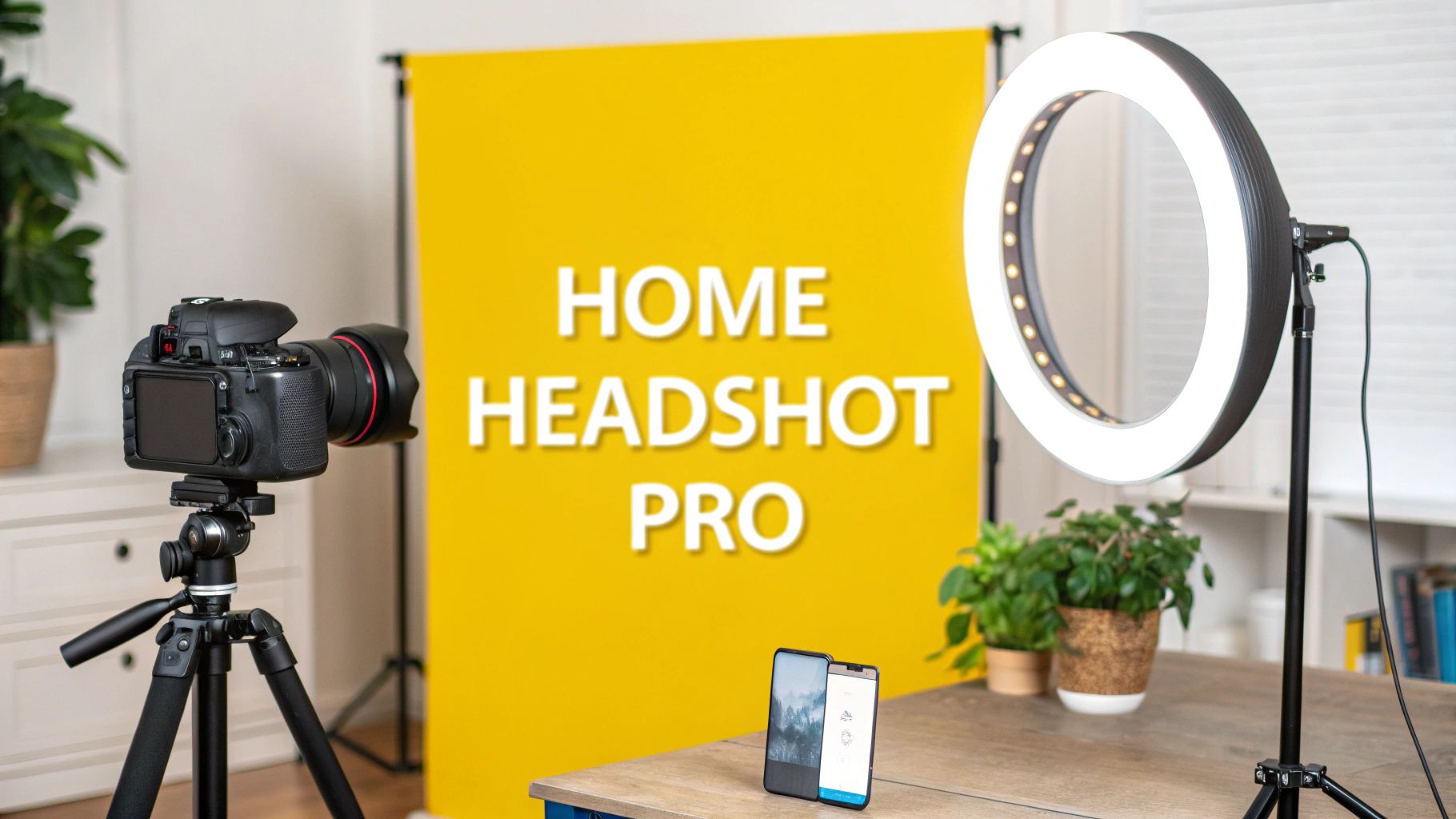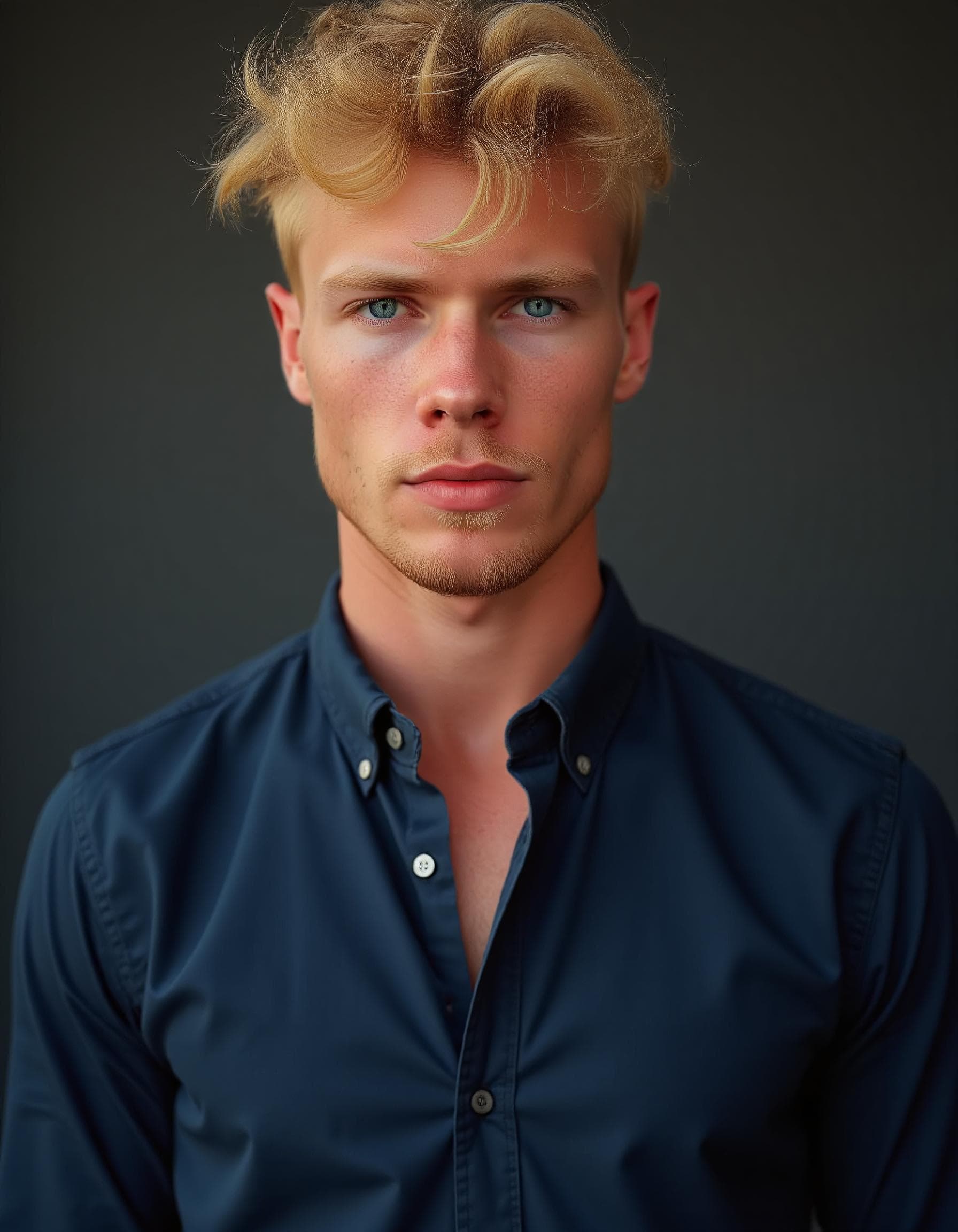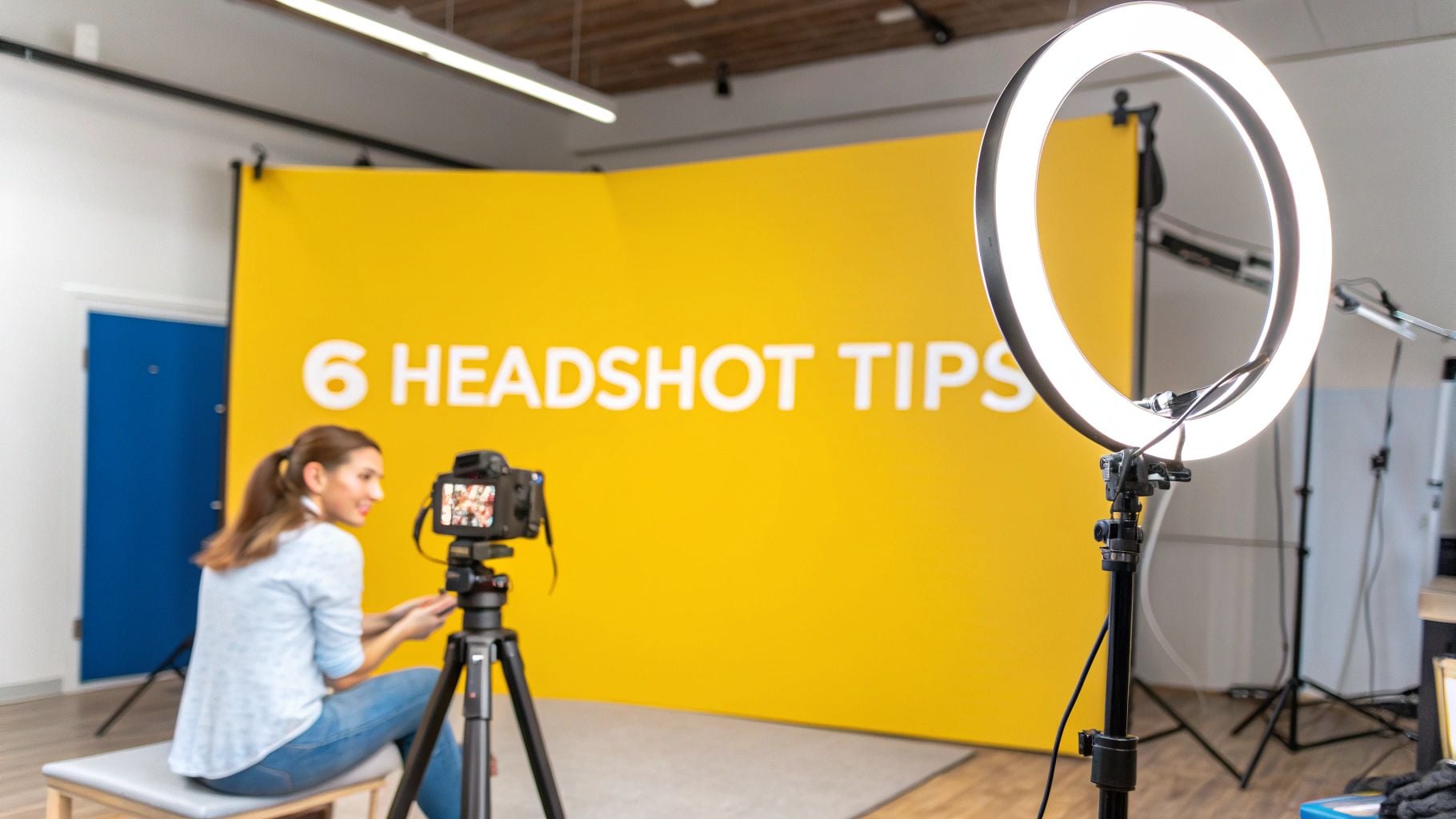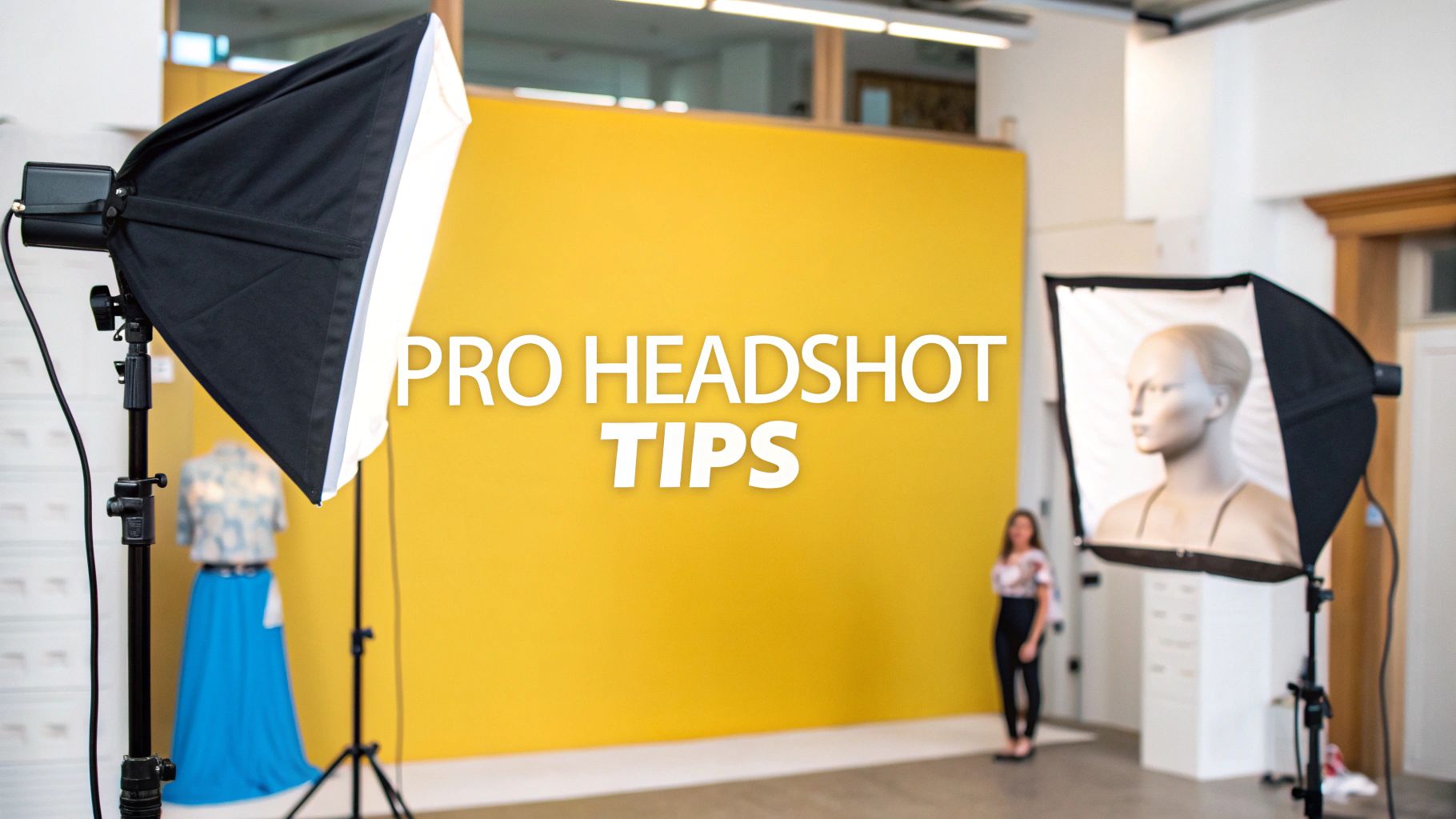Taking a professional headshot at home comes down to three key steps: finding soft, natural light (like from a window), choosing a simple, uncluttered background, and positioning your camera slightly above eye level. Mastering these basics will help you create a high-quality photo that makes an excellent first impression on any professional platform.
Why a Professional Headshot Is Essential
In today's digital world, your online profile is often the first point of contact. Your headshot has become a vital part of your professional identity—it's your virtual handshake with recruiters, clients, and colleagues. A polished, friendly photo can significantly shape how others perceive you online, setting a positive tone before you even meet.
This isn't just an opinion; data supports it. Around 70% of employers globally consider a professional headshot an important factor when evaluating candidates. Platforms like LinkedIn, company websites, and even your video call profile are the new "first meeting" spaces. Studies also show that people form an opinion about someone's trustworthiness in as little as 100 milliseconds just from looking at their photo.
Making a Lasting First Impression
Your headshot works hard for your professional brand.
- It Builds Trust: A clear, high-quality photo makes you seem more credible and approachable.
- It Conveys Professionalism: It shows that you care about your personal brand and how you present yourself.
- It Creates Recognition: Using the same great headshot across all professional platforms helps people recognize you instantly.
The skills you learn taking your own headshot—like lighting and framing—are the same ones needed for effective video interview preparation. That's a valuable skill in today’s remote-first work environment.
Achieving a studio-quality look at home may seem daunting, but modern technology makes it easier than ever. Whether you're using a smartphone or a DSLR camera, you have powerful tools available. The goal is to create a headshot that not only looks professional but also feels authentically you.
Setting Up Your At-Home Photo Studio
You don't need a large, dedicated studio to get professional-quality headshots. A small, well-chosen corner of your home can work perfectly. The most important element isn't expensive equipment; it's good natural light.
Start by finding a spot near a large window. This will be your main light source, providing the soft, diffused light that is very flattering for portraits. Avoid direct, harsh sunlight, which creates strong shadows and can make you squint. An overcast day is ideal, but a window that doesn't receive direct sun works just as well.
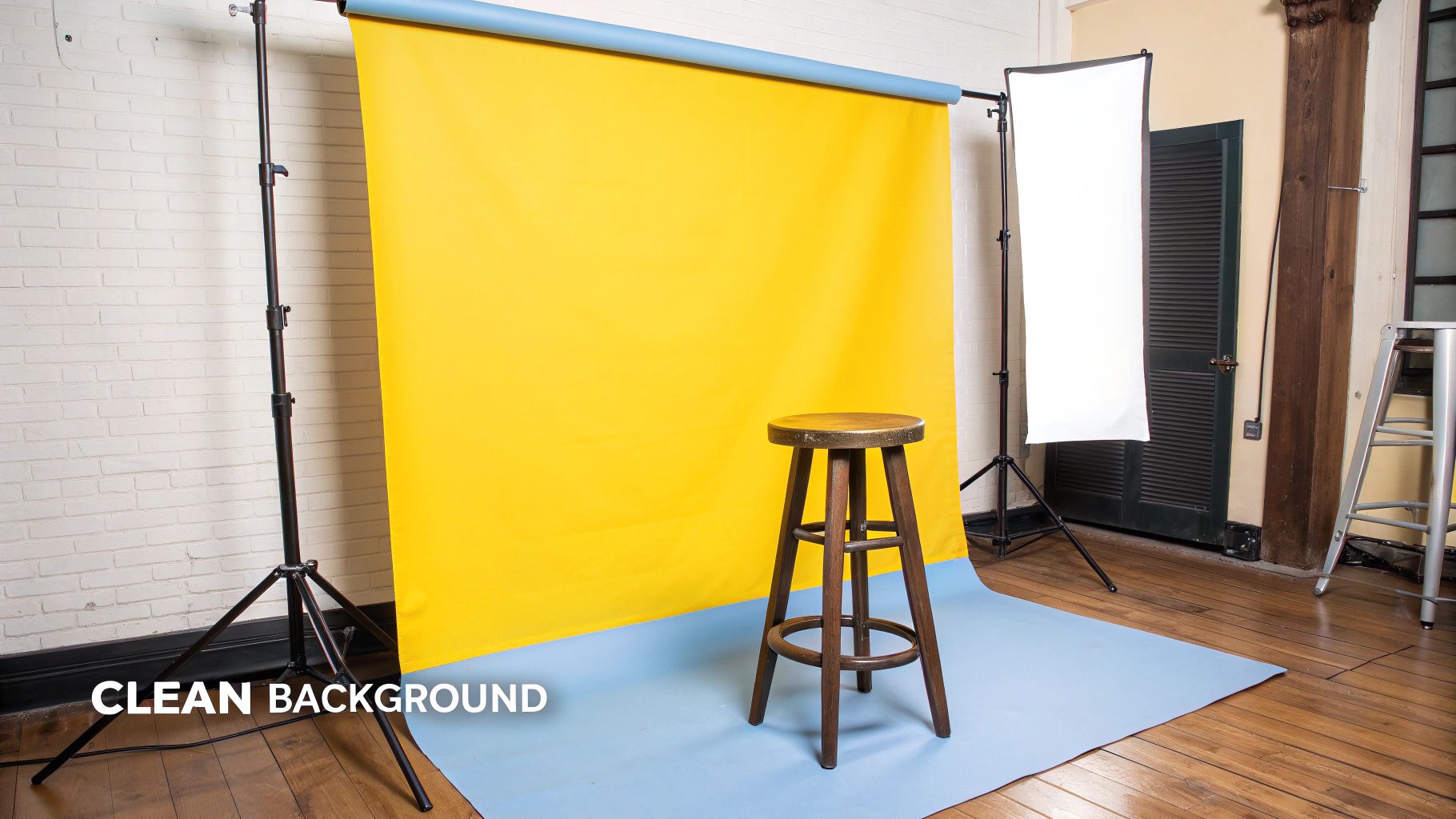
Find the Right Background
Once you have your light source, the next step is the background. Simplicity is key. A cluttered or distracting background can make an otherwise great photo look unprofessional.
Look for a plain, neutral-colored wall—light gray, off-white, or beige are all excellent choices. If you don't have a suitable wall, you can create a clean backdrop by hanging an ironed bedsheet. White or gray will provide the most professional look. The goal is to remove any visual distractions that take the focus away from you. This idea aligns with basic space planning principles, where the environment is optimized for a specific outcome.
Position Yourself for Flattering Light
Your position relative to the window is critical for creating a compelling portrait.
Face the window at a slight angle, roughly 45 degrees. This classic setup allows the light to illuminate one side of your face more directly while softly lighting the other. The result is a portrait with depth and dimension, avoiding harsh shadows.
A useful tip: Turn your body slightly away from the camera, then turn your head back to face it. This small adjustment creates a more dynamic and engaging pose than a flat, passport-style photo.
Ensure you have a few feet of clear space around your chosen spot. This gives you room to move and prevents stray furniture or clutter from appearing in the shot. Taking a few minutes to prepare your space will significantly improve the final quality of your photos.
Choosing Your Gear and Camera Settings
You don’t need expensive equipment to get a fantastic headshot. The technology you already own—whether it’s a modern smartphone or a DSLR camera—is likely sufficient. The key to a great photo isn't the cost of your gear, but knowing how to use it effectively.
Here’s how to get the most out of what you have.
Camera Options for Home Headshots
The best camera is often the one you are most comfortable using. Both smartphones and dedicated cameras can produce excellent results, each with its own advantages.
| Feature | Smartphone (e.g., iPhone, Android) | DSLR/Mirrorless Camera |
|---|---|---|
| Ease of Use | Very intuitive. Point, tap, and shoot. Great for beginners. | Steeper learning curve with manual settings, but offers more control. |
| Key Setting | Portrait Mode is your best friend for background blur. | Manual control over aperture (f-stop) for precise depth of field. |
| Cost | You likely already own one. | Requires an upfront investment in a camera body and lens. |
| Best For | Quick, high-quality shots for professional profiles without technical complexity. | Photographers who want full creative control and the highest possible image quality. |
A modern smartphone is a powerful tool and is perfect for most people's needs. If you already own a DSLR, however, it’s a great opportunity to use its full potential.
If You're Using a Smartphone
Your phone’s camera is very capable. To get a professional look, Portrait Mode is essential. It digitally creates a blurred background (known as bokeh), which makes you stand out as the subject.
Once in Portrait Mode, a few adjustments can make a big difference:
- Set Your Focus and Exposure: Tap on your face on the screen to tell the camera where to focus. A sun icon or slider will appear; adjust it until your skin tones look natural and well-lit.
- Lock It In: After setting the focus and brightness, press and hold on your face until you see "AE/AF Lock." This stops the camera from readjusting as you move slightly.
Avoid holding the camera for a selfie, as even steady hands can cause blur. Prop your phone on a stack of books, a shelf, or a tripod to keep it perfectly still.
If You're Using a DSLR or Mirrorless Camera
Using a DSLR allows for more control over settings. The most important setting for a headshot is the aperture.
To achieve a soft, out-of-focus background, use a wide aperture. This means setting your lens to a low f-stop number, typically between f/2.8 and f/5.6. A lower number creates a shallower depth of field, which isolates you from the background and gives your photo a professional finish.
Pro Tip: Use the camera's self-timer. Setting a 5 or 10-second timer gives you a moment to position your hands, relax your shoulders, and strike a natural pose. It is much more effective than using a remote or rushing to press the shutter.
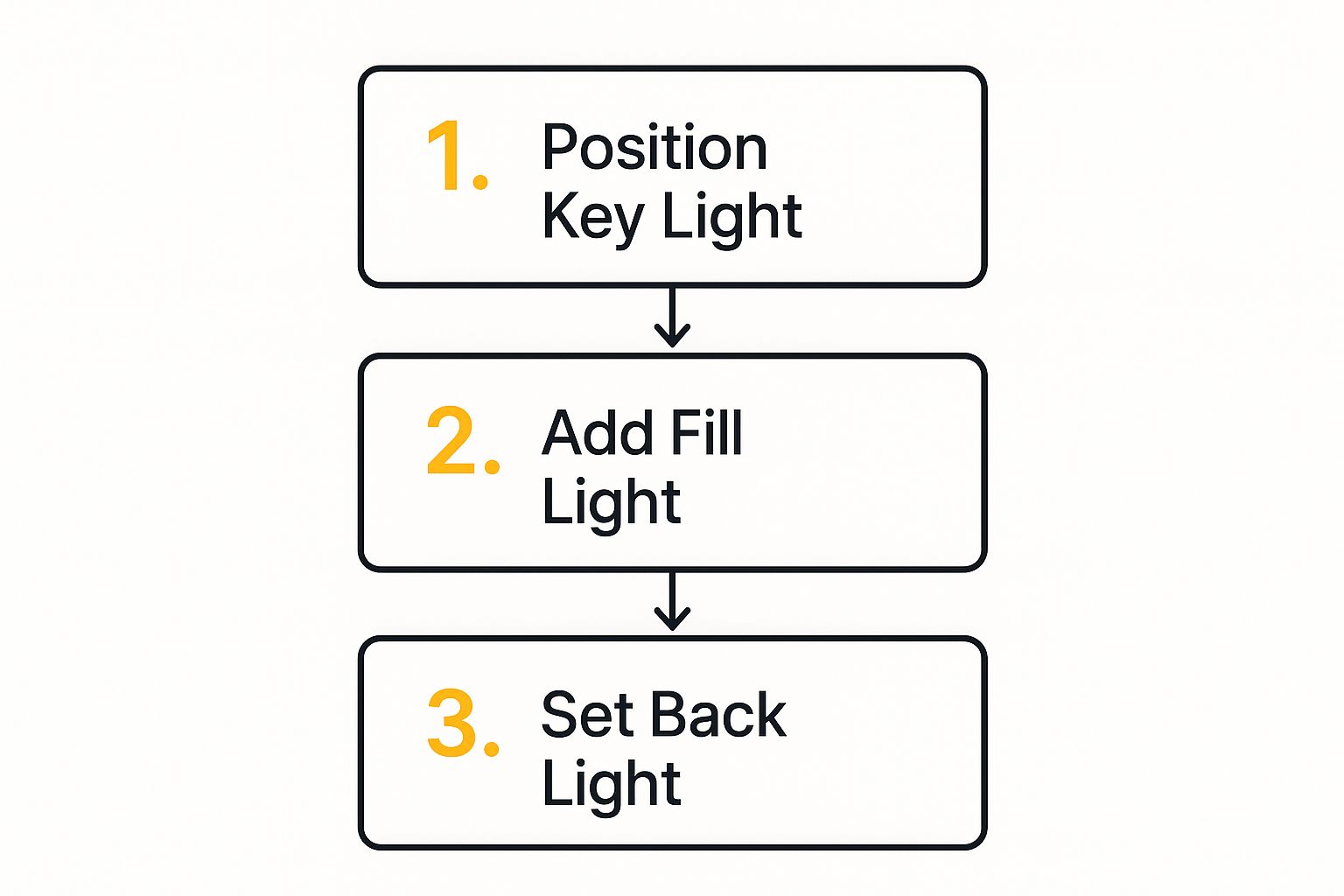
No matter which camera you choose, remember that the quality of your final headshot depends on the quality of the initial photo. Taking the time to capture a sharp, clean, and well-lit image is the foundation for a great result.
Of course, if adjusting settings and arranging lights feels too complicated, AI-generated headshots offer a simple alternative. Services like Professional AI Headshots from Headyshot can use your best casual photos to create an entire gallery of professional-grade headshots, saving you time and effort.
Nailing Your Lighting and Pose for a Memorable Headshot
With your camera and background ready, it's time to focus on the two elements that truly define a headshot: lighting and posing. This is how you can transform a simple snapshot into a professional-looking portrait.
The best light is usually the soft, natural light from a window. Instead of standing directly in front of it, position yourself facing the window but slightly to one side. This allows the light to hit your face at an angle, creating soft shadows that add depth without being harsh.
Avoid direct sunlight, as it is too intense. Choose a time of day when the sun isn't shining directly into your window, or shoot on an overcast day. Cloudy skies act as a large, natural softbox, providing even and flattering light.
The Pro Trick for Balanced Light
If you take a photo near a window and notice that one side of your face is bright while the other is in shadow, there is a simple solution.
All you need is a white object, such as a piece of white poster board, foam board, or even a plain white t-shirt. Hold it just out of the camera's frame on the side of your body opposite the window.
This object acts as a reflector, catching the window light and bouncing it back into the shadows on your face. The effect is immediate: it brightens the darker side, reduces harsh shadows, and gives you a more polished and professional look.
How to Pose with Confidence
Posing for a photo can feel unnatural. The goal is not to strike a complex pose but to look relaxed, confident, and approachable. Facing the camera directly is a common mistake that can result in a flat, "mugshot" style photo.
Instead, try this classic posing technique:
- Angle Your Body: Start by turning your body about 45 degrees away from the camera.
- Turn Your Head: While keeping your body angled, turn just your head back toward the camera.
- Push Your Chin Forward: Gently push your chin forward (toward the camera) and slightly down. This may feel unusual, but on camera, it helps define your jawline.
This simple sequence creates a more dynamic and engaging look.
A genuine expression is the most important part of a headshot. Just before the photo is taken, think of something that makes you genuinely happy—a fond memory, a funny joke, or someone you care about. This will bring a natural smile to your eyes, making you appear more authentic and trustworthy.
People form a first impression in under 150 milliseconds. This incredibly short timeframe is why even a DIY headshot needs to look credible.
Mastering these lighting and posing fundamentals will provide a solid foundation for a great headshot.
Deciding What to Wear for Your Headshot
Your choice of clothing in a headshot communicates a message about your professional identity. Your outfit should complement your appearance, not distract from it.
The main objective is to ensure your face and expression are the focal point. Solid colors are almost always the best choice. They create a clean, simple background that allows you to stand out, rather than drawing attention to a busy pattern or logo.
Match Your Outfit to Your Industry
Consider the professional norms in your field. A lawyer or financial advisor might choose a dark blazer to project authority. For a freelance writer or UX designer, that same outfit might feel too formal. A quality knit top or a simple, well-fitted sweater can communicate creativity and a more relaxed professionalism.
If you are unsure, ask yourself: "What would I wear to an important meeting or interview in my industry?" That is often the right choice. Your headshot should represent the professional you.
Helpful Tip: Before your photoshoot, put on your chosen outfit and take a few quick pictures with your phone. Colors and fabrics can look different on camera. This simple test can help you avoid an awkward fit or unflattering fabric sheen.
Getting the Colors and Details Right
Choose colors that complement your skin tone. Jewel tones—such as sapphire blue, emerald green, and deep reds—tend to look good on most people. Classic neutrals like navy, charcoal gray, and cream are also safe and professional choices. Try to avoid wearing a color that is too similar to your background.
Finally, pay attention to the details. Ensure your hair is neat and styled as you would typically wear it for work. A polished appearance shows you are serious and professional.
Take Your DIY Photos to the Next Level with AI
You've followed the steps and taken some great, well-lit photos at home. Now, you can give those images a professional finish without using complex editing software like Photoshop.
AI headshot generators are a powerful tool for this. They take your best casual shots and transform them into a full gallery of studio-quality options. AI can change your background, adjust your outfit for different professional settings, and perfect the lighting for a crisp, polished look.
Why It’s a Smart and Efficient Choice
This method offers significant advantages in speed and cost. AI-generated headshots can be up to 8 times cheaper than a traditional photographer. The turnaround time is also very fast—you could have up to 200 unique headshots ready in just a few hours.
For a detailed comparison, you can explore the cost benefits of AI headshots.
This makes it incredibly easy to keep your LinkedIn profile, resume, or company website updated with a fresh, professional image. AI enhances your DIY efforts, turning your best photos into a complete professional portfolio. You can also discover other best AI tools for job seekers to support your career search.
The key advantage is having a variety of options. You can use a few photos taken in your living room to generate headshots suitable for a corporate biography, a creative industry profile, or a more casual social media look, all without a new photoshoot.
Common Questions About Home Headshots
Even with a detailed guide, some questions often arise when setting up a home headshot session. Here are answers to some of the most common ones.
What’s the Best Background for a Professional Headshot?
Simplicity is best. A background that doesn't distract from you is ideal. A solid, neutral-colored wall—such as light gray, off-white, or muted beige—is an excellent choice.
If you don't have a suitable wall, a freshly ironed sheet or an affordable photography backdrop can work well.
The goal is to avoid anything distracting, such as busy patterns, cluttered bookshelves, or prominent art. The background should support your image, not compete with it.
Can I Really Get a Good Headshot with My Smartphone?
Yes, absolutely. Modern smartphone cameras are very powerful and more than capable of producing a high-quality headshot.
For the best results, remember these key points:
- Use the back camera. It has a higher-resolution sensor than the front-facing "selfie" camera.
- Use Portrait Mode. This feature creates a blurred background, mimicking the effect of a professional lens.
- Light is crucial. Find a spot near a large window with soft, indirect natural light.
- Keep it steady. Use a tripod or prop your phone on a stable surface like a stack of books to avoid blur.
How Do I Make My Smile Look Natural and Not Forced?
A forced smile is easy to detect. The key to a genuine expression is connecting with a real emotion.
Just before you take the photo, think of something that genuinely makes you happy—a pleasant memory, a funny joke, or a project you're excited about. This will create a natural spark in your eyes and a more authentic smile.
Another useful technique is to aim for a soft smile rather than a wide grin. Instead of saying "cheese," which can tense your facial muscles, try practicing in a mirror to find an expression that feels natural and represents you well.
After you've captured your photos, achieving that final studio polish can be challenging. If you prefer to skip the editing process, an AI-powered tool offers a great solution. Our AI Headshot Generator uses your best DIY photos to generate a wide range of professional headshots, providing you with many polished options in just a few minutes.
